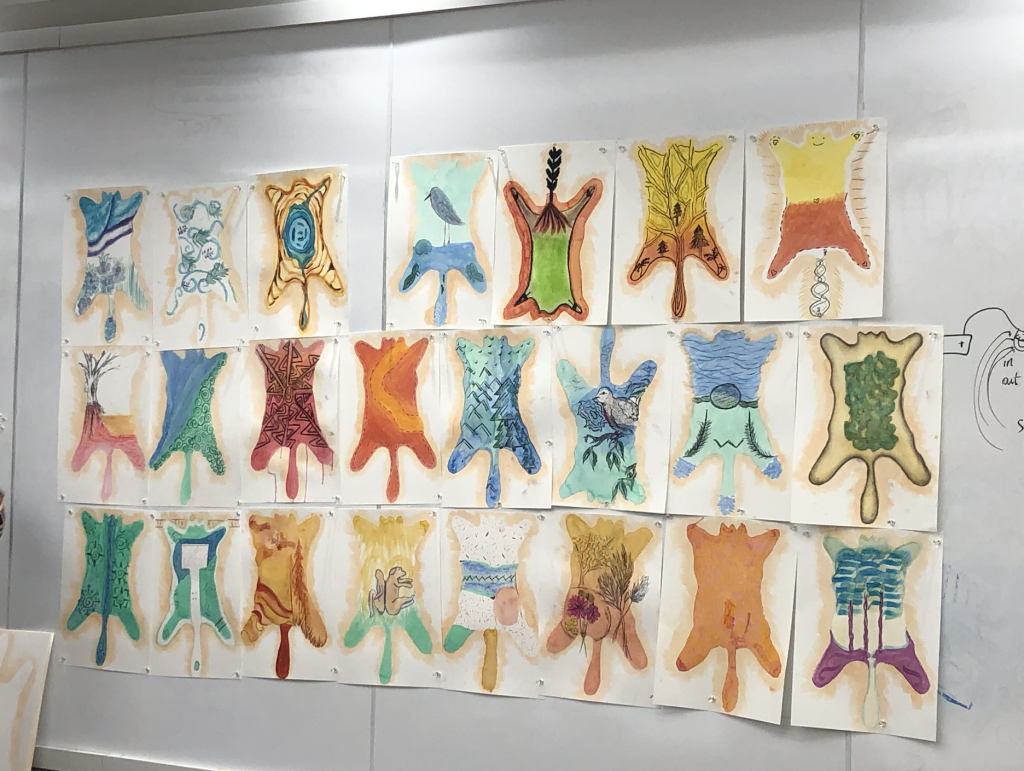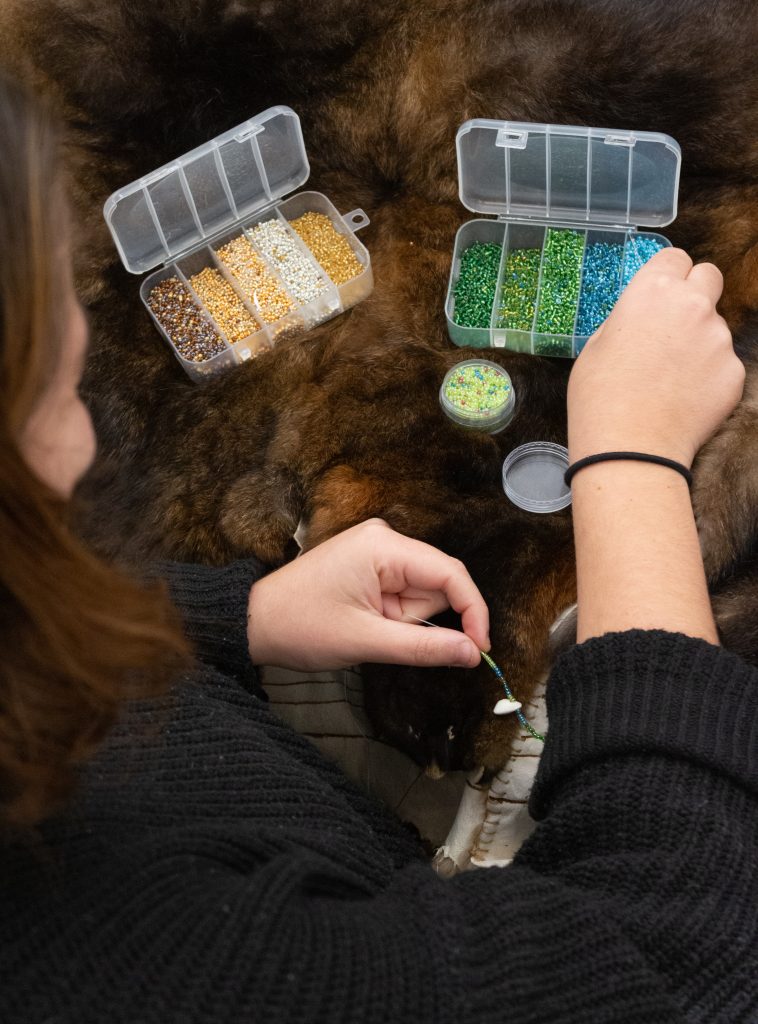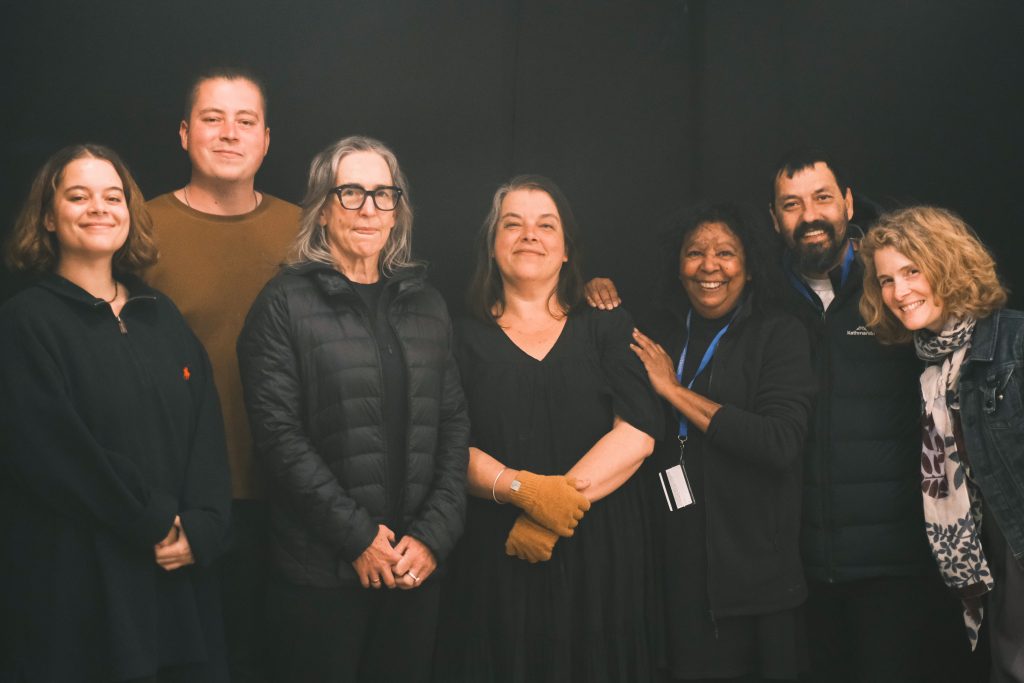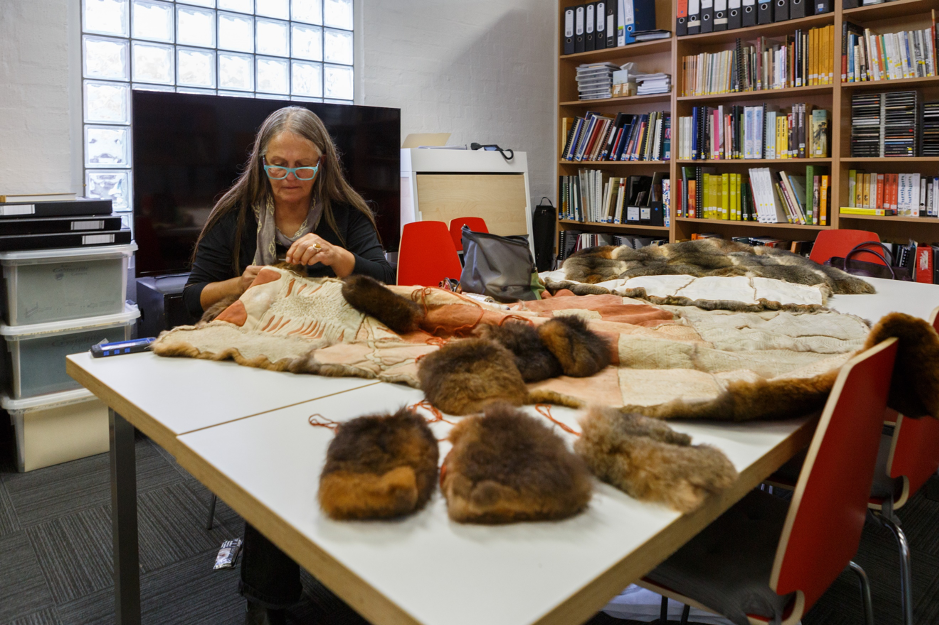Acknowledging Museums as Colonial Institutions
In the words of Amy Lonetree’s, Decolonizing Museums: Representing Native America in National and Tribal Museums (2012), “Museums can be very painful sites for Native peoples, as they are intimately tied to the colonization process” (Lonetree 1). Museums are typically presented as sites of learning, engagement, and history, and Lonetree’s quote leads to a path of recognizing the harm that these colonial institutions cause, historically and to this day. Lonetree’s words have contributed to an ongoing conversation about colonial institutions (galleries, libraries, archives, and museums, or GLAMs) and how decolonization may recreate these places as sites that are beneficial for Indigenous peoples. Decolonization is noted by Eve Tuck and Wayne Yang (2012) as “bring[ing] about the repatriation of Indigenous land and life…” (Tuck and Yang 1).
In our spring 2022 course Decolonizing Museums, we work to understand museums as colonial spaces and how “decolonization” can reimagine them (and perhaps, in the future, restructure them) into places that recognize and prioritize Indigenous people and their narratives.
Unlearning Colonial Socialization
The commodification of decolonization arises as a challenge (akin to many efforts that are done to counter social issues) to use this framework in a way that can apply to institutions like museums or even the education system. “Decolonization” has become a buzzword plastered on tote bags, t-shirts, and mugs, allowing people to “show off” their “inner activist” while requiring little to no reflection on the role that they play in colonialism. Maddee Clark, a Yugambeh writer, expresses that “…institutions would utilize decolonization as a buzzword without interrogating their own deeply held values or developing sincere relationships with First Nations people” (Clark 2021). To clarify, Clark’s statements focus more on the art community in Australia, though rings true even here in the United States and in the actions of institutions here that commit to their performance.
Clark goes on to mention a personal encounter, where he was invited to an exhibit with a white curator that “wanted to decolonise” her organization’s board. The same white curator invited Clark to an event where participants sat in a circle on the floor “to decolonise the space by complicating the usual expectations of panel discussion”. These moments illustrate how empty decolonizing attempts can be when they are adopted without committing to internal work and reflection. By failing to build legitimate relationships with Indigenous people and exposing them to (what appears to be) uncomfortable situations, more harm is being committed.
Additionally, educational systems and museums claim that they implement decolonial learning and methods, while straying from acknowledging the harm that they cause and what they should do to be in service of Indigenous students and people. If we want to reference “decolonization,” it is vital that we work to unlearn the ways that we’ve been socialized and prepare to be critical of ourselves to recognize our beliefs and the harm that they may bring. Our ways of exchanging knowledge, communicating, and building community must be revised in order to aid in this process. We must also centralize Indigenous voices while ensuring that the burden of rebuilding entire colonial institutions does not fall on their shoulders. Acting as more than allies, we need to prepare to be present and ready to listen and/or act as needed.
Artmaking: Another Way of Learning

In Decolonizing Museums, we’ve identified core memories of engaging with spaces like libraries: you enter quietly, limit conversation unless absolutely necessary, and walk around towering shelves filled with countless books. The content of these books may prioritize certain narratives over others, leaving visitors to feel excluded. Even in the education system, lectures are the main teaching method and showcasing what you’ve learned may limit you to writing papers or completing exams. But what if there was another way to learn that allowed you to be more interactive with your teachers and peers — a way that acknowledged the need to pass down information and your humanity/ personal history?
One method of decolonizing is referencing ways of learning that are outside of Western education methods. By validating and understanding other ways of sharing knowledge, we may be able to work against colonial institutions. Throughout this class, we’ve learned about Indigenous ways of knowledge production and how it works against (colonial) institutions. Centralizing southeastern Australian possum-skin cloak-making traditions that have been revived through the work of Maree Clarke (Mutti Mutti/ Wemba Wemba/ Boonwurrung), Vicki Couzens (Kirrae Wurrong/ Gunditjmara) and Lee Darroch (Yorta Yorta), we’ve been able to understand Indigenous ways of knowledge sharing to rework our perception of learning.
Specifically, working with Maree Clarke and her family-members:
- Molly Mahoney (Boonwurrung / Wemba Wemba / Barkindji)
- Mitch Mahoney (Boonwurrung / Wemba Wemba / Barkindji)
- Kerri Clarke (Boonwurrung / Wemba Wemba)
- Nicholas Hovington (Palawah)
A collaborator of Maree’s, Senior Researcher Fran Edmonds, expresses that, “Storytelling is an Indigenous knowledge practice, and, increasingly, a methodological and theoretical intervention seeking to decolonise Western knowledge production in the academy” (Edmonds et al. 2020: 279). Storytelling and observation were the main methods that Maree and her family used with our class to share their knowledge with us. We listened to Mitch and Kerri retell stories about the Seven Sisters, participated in a “Country Immersion” exercise where we were encouraged to follow Kerri’s voice to the background of sounds from wildlife and think through questions she read to us, and we painted our own relations to place/Country on large pieces of paper using ink and charcoal to carefully think this through in our own contexts. These activities allowed us to not only engage with Indigenous cultural traditions in a respectful manner, but it also allowed us to experience ways of Indigenous learning that encourages listening to one another, sharing our stories, and reflecting on our time with one another.
Maree and her family opened our class to a new way of learning that made us reflect on our connection to ourselves, each other, and our land. This new mentality pushes against the Western concepts of education that forces a strong ideology of individualism on people.
Reflecting on this process with a classmate and how it helps with decolonizing, she replied that art-making: “[Is] a process of unlearning and thinking of the things to me that look normal and are a given and that it’s not true. There’s many ways to do things…”
To experience learning from and with Maree and her family has been a life changing experience- one of building community and keeping Indigenous ways of learning alive and validated.
What is the “Living Archive” and why is it important?
As a class, we have defined the Living Archive as a non-Westernized way of upholding Indigenous sovereignty through the collecting and circulating of Indigenous forms of knowledge (both tangible and intangible).
- The Living Archive has…
- allowed archivists to focus on detail and rethink what an archive actually is;
- given Indigenous stories and figures the ability to reclaim their place in history;
- allowed for Indigenous communities to “speak back” to the violence of the Western archive;
- The importance of the recital of poetry and reading in the original First People’s language (Leane)
Indigenous scholars and the Living Archive:
Bruce Pascoe is an Indigenous Australian author who is using his farm as a way of “speaking back”, which therefore makes it a part of the Living Archive. It is also important to note that Indigenous agency is something that is as well practiced on Pascoe’s farm. Pascoe explained to our class that he only works with Indigenous farmers, that way they can be paid for their labor and be nourished by food that they are planting themselves. The Indigenous farming practices on Pascoe’s farm include but are not limited to:
- Repeated harvest: the altering of behaviors of animals and genomes of plants;
- The domestication of plants: done by continued harvesting of plants;
- Building a fortress of food to shield Indigenous people from the law.
“We do not own the land, the land owns us;” “we are in possession even though we say we do not own mother Earth.”
Bruce Pascoe, 2022
Jeanine Leane is an Indigenous Australian writer and poet who focuses on using poetry as a form of storytelling and uses storytelling as an expression of Indigenous sovereignty. In order to begin decolonizing Westernized archival constructs, Leane is using her poetry as a part of the Living Archive in that it uses the power of memory and anecdotes: starting with someone’s story and working backwards (rather than having a physical record).
“The archive is really not non-fiction, it is violent and misrepresentative.”
Jeanine Leane, 2022
“History does not have the first claim, nor the last word.”
Jeanine Leane, 2022
How is storytelling a part of the Living Archive and why is it important?
At the end of our class, we have come together to make our possum-skin cloak, which tells many stories of the Seven Sisters (Pleiades). Making the possum-skin cloak is a form of storytelling because as we make the cloak, stories are being shared, we are picking up skills, and we are learning. As we learn and unlearn, we must endeavor to understand Indigenous ways of being that are often dismissed or invalidated, and storytelling is one of those we must examine. Through our gathering and making together, there has been a transmission of knowledge between generations and cultures facilitated by storytelling. This is very different from the traditional idea of learning seen in academia, where there exists a rigid hierarchy between those learning and those teaching, and students follow a certain format of learning including reading and writing. These are both ways in which learning can occur.
Storytelling is just as valid as these western ideas of learning in academia. As we make the cloak, we are practicing another way of demonstrating learning. We are using a form of tactile learning while making the cloak, and using our bodies to learn. Perhaps storytelling might be a more valid way of learning. In-person learning together is rich and fun, more accessible, and doesn’t require its participants to learn all the complex rules in academia that bar entry to outsiders. Individualism is often emphasized in the academy, whereas with cloak-making we are learning together as a community. No research is done in a vacuum, and it is more realistic to learn and grow with each other. Besides those reasons, First Nation storytelling can also interrupt the static stories curated by colonial institutions and proclaim the continuation of their culture into the present.
When asked about how this type of learning feels different from traditional academic learning, students responded:
- “Being physically in the room with the people we’re learning from…has been really impactful.”
- “Getting to work with other people, hearing their stories, has been really special. It’s something you can’t replace with a zoom screen.”
- “When learning with your hands and actively participating, I find myself more engaged and excited to learn.”
How Sovereignty is Expressed
Through Our Cloak- Making

Visual Sovereignty
Our cloak/art-making not only challenges Western ways of learning, but also interrogates Western conceptualizations of sovereignty. By participating in cloak/art-making, Indigenous sovereignty becomes enforced in a way that transcends settler-colonial boundaries.
Jolene Rickard’s coining of the term “visual sovereignty” helps us understand the link between art-making and sovereignty more clearly: to Rickard, putting “visual” before “sovereignty” allows us to imagine other forms of sovereignty that stray away from ties to statehood (Rickard 2020).
Wemba-Wemba & Gunditjmara woman, visual artist, curator, writer, and lecturer Paola Balla also helps us conceptualize visual and Indigenous sovereignty by arguing that sovereignty is:
“an inalienable, innate and intimate right; its expression can be found buried within artistic works, gently emerging from inherited practices, or boldly spelled out in new artistic forms.”
(Balla 2017, 13)
Sovereignty Beyond Western Articulations
As both Rickard and Balla articulate, Western sovereignty is connected to territory, a protection of boundaries, and a nullification of Native peoples’ sovereignty—also known as terra nullius, “empty land.” Indigenous sovereignty, on the other hand, is:
- inalienable and therefore cannot be separated from the person or entity that claims it (Indigenous sovereignty is never gone);
- expressed through diverse art forms and embodied practices intergenerationally;
- being asserted now (sovereignty is not old; it is contemporary);
- a political crusade led by Victorian Aboriginal women.
Indigenous sovereignty therefore does not have to be given, is embedded in place, is powered by matriarchy, is oriented to the future, and is expressed through art making.
As Balla argues, the processes of decolonization are in direct support of Indigenous sovereignty, as non-Indigenous folks are able to decolonize and reimagine the term “sovereignty” as it relates to art and Indigenous knowledge systems.
Our class’s collective cloak/art-making therefore brings both Indigenous expressions of sovereignty and decolonization together.
Examples of Visual Sovereignty
We are not the only ones engaging in art-making and visual sovereignty. Composed of four Aboriginal women, the Unbound Collective aims to transform understandings of sovereignty, ethics, decolonization, storytelling, institutionalization, history, and representation through making and performing.
The Collective asks, “Who speaks? Who listens?” and attempts to perform the immediate expressions of their memories, love letters, resistance, and activism. (Baker 2014).
Narungga writer Natalie Harkin writes that the Collective’s images are:
“an act of public intimacy that involves love and risk,” thus creating new narratives that “leave an indelible footprint;” one that ruptures the truth that the colonial archives have put forth.
(Harkin 2015, 22)
The work of the Collective is therefore vital in decolonizing the archive and reasserting Indigenous sovereignties that are currently disavowed through white possession.
Reflections from the Artists

Learning about the Unbound Collective’s work in class, as well as gaining valuable mentorship through our generous visiting Aboriginal artists, has helped us comprehend the ties between art-making, sovereignty, and decolonization.
Reflecting on how Indigenous sovereignty is tied to our collective cloak making process, Mitch says,
“Cloak-making is a way of telling stories about Country and land, but is also a way of telling our own personal stories.”
Mitch Mahoney (Boonwurrung / Wemba Wemba / Barkindji)
Kerri similarly reflects on her own personal relationship to Country—an Indigenous idiom for land and all of the relations that come from the land—visual sovereignty, and art-work, arguing that:
“Country is a belief system that goes beyond Western definitions of land. Art-making helps us connect to Country, Aboriginal identity, culture, language, and laws.”
Kerri Clarke (Boonwurrung / Wemba Wemba)
Reflecting on the Resurgence of Cloak Making

Photo credit: Jenny Yu for MHC’s Office of Communications
Our Cloak-Making As Part of a Larger Movement
Our collective cloak-making does not stand alone—it is directly tied to a bigger revitalization movement. This movement is spearheaded by Aboriginal communities across south-eastern Australia who are working to bring back the Possum Skin Cloak, an artwork that represents Aboriginal collective identity, community, belonging, ancestors, and cultural knowledge systems.
The Revitalization Movement
In Possum Skin Cloaks Then and Now, Keerray Woorroong Gunditjmara multi-media artist, Dr. Vicki Couzens, traces the resurgence of the Possum Skin Cloak in Aboriginal communities across south-eastern Australia.

Photo Credit: Australia Council for the Arts
Dr. Couzens argues that because these cloaks tell Aboriginal stories of belonging, place, and the sacred and spiritual, they represent an iconic sense of collective identity and belonging that allows Aboriginal communities to gain an understanding of their un-ceded sovereignty.
Amidst the past and present effects of settler colonialism, Possum Skin Cloaks are therefore a “continuing story cycle [that keeps] Country strong through the reclamation and restoration of cultural knowledge.”
Dr Vicki Couzens (Keerray Woorroong Gunditjmara), Possum Skin Cloaks Then and Now
Dr. Couzens clearly articulates how these cloaks are used today (for Welcome to Country ceremonies, everyday use, community ceremonies, etc) and argues that their use today builds upon and continues their use in the past.
By comparing their use today with their use in the past, Dr. Couzens illustrates how the resurgence of Possum Skin Cloaks brings Aboriginal communities closer to the actions of their ancestors, leaving a lasting legacy that directly challenges the silencing of their past, the erasure of their traditions, and the forced assimilation of their children.
The efforts of Aboriginal folks to bring Possum Skin Cloak-making back to their own communities should therefore not be overlooked or ignored, because the cloaks signify a broader decolonizing and revitalizing practice that fights back against the silencing efforts of settler colonialists.
Reflections from the Artists

Without a doubt, our visiting artists have a large place in this broader revitalization movement. As described in the “History” section of this course website, Maree has helped create possum skin cloaks around the world—in classrooms, within families, and even in museums.
For Molly, the revitalization of the possum skin cloak allows her to learn about the traditions of her own ancestors.
“Learning about these traditions will allow me to pass them onto my future children, which is super important to me,” Molly says. “I would’ve never been able to pass these traditions down if it weren’t for our efforts to bring the cloaks back.”
Molly Mahoney (Boonwurrung / Wemba Wemba / Barkindji)
Mitch also looks forward to passing on these traditions to his future kids, who would pass it down to their kids, and so on.
“It’s empowering for me because creating possum-skin cloaks is a form of reclaiming something that was openly targeted by colonists,” Mitch adds. “We are reclaiming our knowledge system, our traditional practices, and we’re telling stories about Country, land and our own lives.”
Mitch Mahoney (Boonwurrung / Wemba Wemba / Barkindji)
References and Works Cited
- Baker, A. G. (2014, September 1). Bound and unbound: Sovereign acts (act 1). Artlink Magazine.
- Balla, P., & Delany, M. (2016-2017). Sovereignty: Inalienable and intimate. Australian Centre for Contemporary Art.
- Clark, M. (2021, November 16). The Crisis of Decolonizing The Arts. Disorganising. Retrieved April 29, 2022, from http://disorganising.co/the-crisis-of-decolonising-the-arts
- Couzens, V. (2020, May 26). Possum skin cloaks then and now – same same but different. The Australian Museum.
- Edmonds, F., Khan, R., Thorner, S., & Clarke, M. (2020). The Living Archive of Aboriginal Art: Expressions of Indigenous Knowledge Systems Through Collaborative Art- Making. revista de estudios globales y arte contemporáneo, 7(1), 267- 311.
- Leane, J., & Harkin, N. (2021). Law’s Documents: Materiality, Authority, Aesthetics (K. Biber, P. D. Vaughan, & T. Luker, Eds.). Taylor & Francis Group.
- Leane, J. (2017, October 12). ‘Cardboard Incarceration’ by Jeanine Leane | States of Poetry ACT – Series One. Australian Book Review.
- Lonetree, A. (2012). Decolonizing Museums: Representing Native America in National and Tribal Museums. University of North Carolina Press.
- Pascoe, B. (2013). Dark emu : Black seeds agriculture or accident?. Magabala Books.
- Rickard, J. (2020). Indigenous Visual Sovereignty. The Power Institute.
- The National New Australian Art. (2019). The Unbound Collective. Artists | The National.
- Tuck, E., & Yang, K. W. (2012). Decolonization is not a metaphor. Decolonization: Indigeneity, Education & Society, 1(1), 1.
Group contact: Bridget Maloney (class of 2024), malon23b@mtholyoke.edu